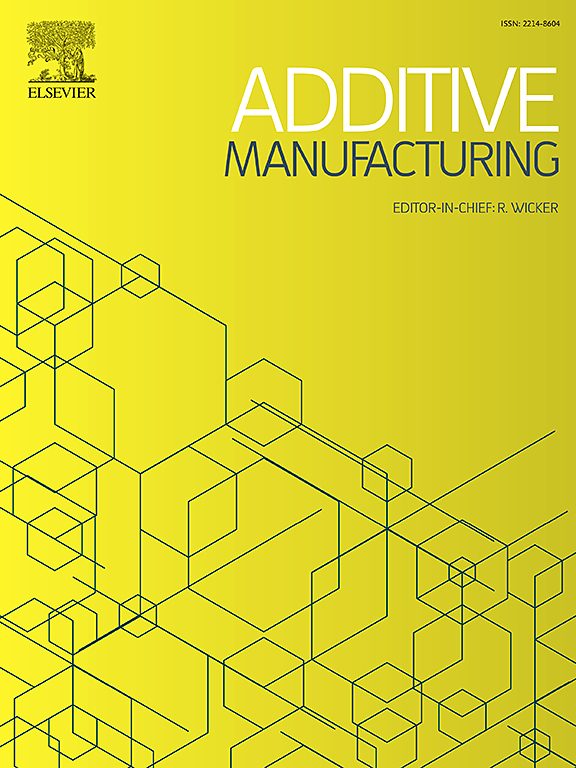Eliminating structural defects in large area mechanical metamaterials via hot lithography in large-area projection micro-stereolithography
IF 10.3
1区 工程技术
Q1 ENGINEERING, MANUFACTURING
引用次数: 0
Abstract
Additive manufacturing has enabled the creation of new classes of architected meta-materials with exceptional structural and functional properties. Large-area projection micro-stereolithography (LAPµSL) has the potential for producing large volume metamaterials with millions of micro-scale unit cells and multiple orders of magnitude in length scales. Nevertheless, as part size grows with increasing number of unit cells, probability of finding embedded defects becomes significantly higher. Structural defects, such as internal cracks and non-uniformity embedded within networks of micro-scale unit cells, often remain undetected due to flawless external appearances. Herein, we elucidate the mechanisms underlying embedded structural defects during the free surface metamaterial printing. Our experimental investigations and theoretical calculations reveal a growing trend of surface tension effect at the interface between solidified pattern and uncured liquid. We found that this surface tension effect plays a dominant role in defect generation. We present a novel approach that uses in-situ Joule-heating to effectively minimize the free surface bulging phenomenon and enables the production of large, defect-free, low-density mechanical metamaterials. Our results are validated through in-situ non-contact resin surface profiling and X-ray computed tomography (XCT), confirming mechanical properties close to theoretical predictions. This work forms the basis of production of large volume metamaterials with millions of micro-scale features for advanced engineering applications.
大面积投影微立体光刻中的热光刻技术消除大面积机械超材料的结构缺陷
增材制造能够创造出具有特殊结构和功能特性的新型建筑超材料。大面积投影微立体光刻(LAPµSL)具有生产具有数百万微尺度单元格和多个数量级长度尺度的大体积超材料的潜力。然而,当零件尺寸随着晶胞数量的增加而增长时,发现嵌入缺陷的可能性就会显著提高。结构缺陷,如内部裂缝和嵌入在微尺度单元胞网络中的不均匀性,往往由于完美的外观而无法检测到。在此,我们阐明了自由表面超材料印刷过程中嵌入结构缺陷的机制。我们的实验研究和理论计算表明,在凝固模式和未固化液体之间的界面上,表面张力效应呈增长趋势。我们发现这种表面张力效应在缺陷的产生中起主导作用。我们提出了一种新的方法,使用原位焦耳加热来有效地减少自由表面膨胀现象,并使生产大型,无缺陷,低密度的机械超材料成为可能。通过原位非接触式树脂表面分析和x射线计算机断层扫描(XCT)验证了我们的结果,证实了力学性能接近理论预测。这项工作为大规模生产具有数百万微尺度特征的超材料奠定了基础,这些超材料可用于先进的工程应用。
本文章由计算机程序翻译,如有差异,请以英文原文为准。
求助全文
约1分钟内获得全文
求助全文
来源期刊

Additive manufacturing
Materials Science-General Materials Science
CiteScore
19.80
自引率
12.70%
发文量
648
审稿时长
35 days
期刊介绍:
Additive Manufacturing stands as a peer-reviewed journal dedicated to delivering high-quality research papers and reviews in the field of additive manufacturing, serving both academia and industry leaders. The journal's objective is to recognize the innovative essence of additive manufacturing and its diverse applications, providing a comprehensive overview of current developments and future prospects.
The transformative potential of additive manufacturing technologies in product design and manufacturing is poised to disrupt traditional approaches. In response to this paradigm shift, a distinctive and comprehensive publication outlet was essential. Additive Manufacturing fulfills this need, offering a platform for engineers, materials scientists, and practitioners across academia and various industries to document and share innovations in these evolving technologies.
 求助内容:
求助内容: 应助结果提醒方式:
应助结果提醒方式:


